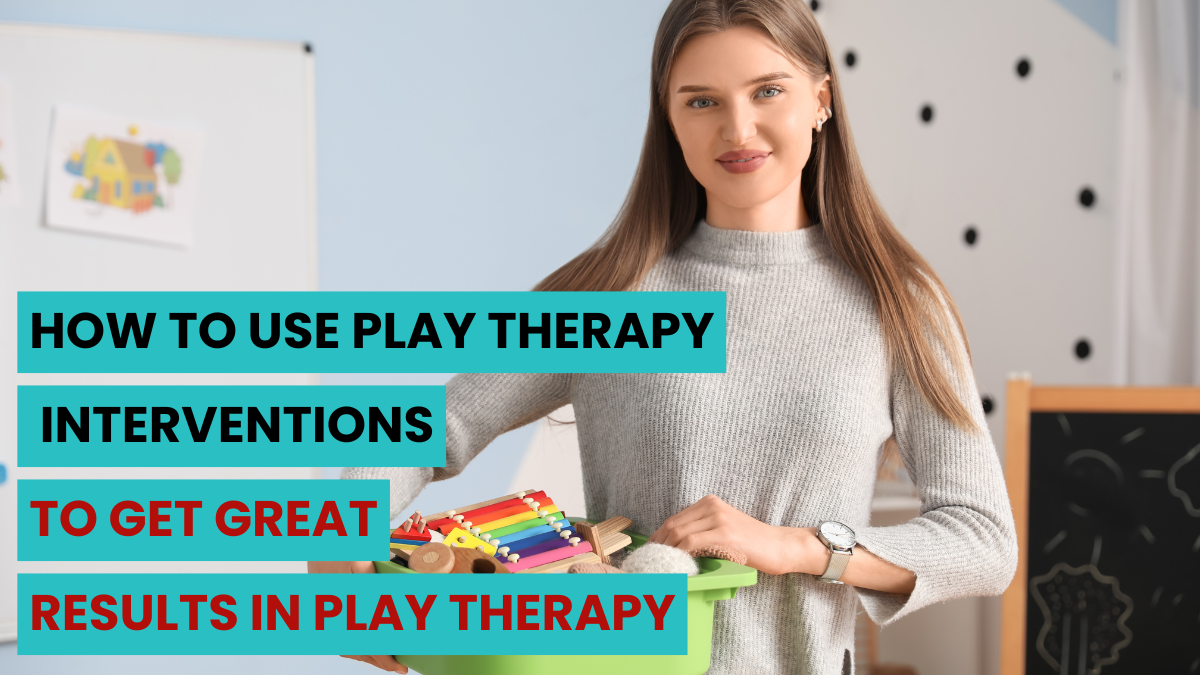How to Use Play Therapy Interventions to Get Great Results in Play Therapy

If you’ve ever caught yourself scrolling Pinterest or Etsy, searching for just the right play therapy intervention—maybe something colorful, clever, or new—you’re not alone. Many play therapists fall into what I call the “Pinterest & Etsy Playroom Trap”: a well-meaning but overwhelming hunt for the perfect tool to use in sessions. But here’s the thing…
If your practice feels confusing or ineffective, the problem isn’t your glitter glue collection. It’s not about needing more toys. The missing piece is likely not what you’re doing, but why you’re doing it.
Let’s break down what actually helps you use play therapy interventions effectively and confidently—with better outcomes for your clients and peace of mind for you.
1. The Common Trap – The “Pinterest & Etsy Playroom”
Let’s be honest. We’ve all been there: standing in the craft aisle with a cart full of beads, clay, and tiny figurines, thinking, “This will make my next session magical.” Or clicking “add to cart” on that adorable anger activity you saw on Instagram. The temptation is real.
But here’s the truth: play therapy is not about having all the things. The glitter jars, the expressive arts kits, the card decks—all of that is only meaningful if it aligns with your theoretical framework. Without that anchor, you’re just throwing spaghetti at the wall and hoping something sticks.
In fact, when you rely too heavily on finding the “right” activity, it can leave you second-guessing your skills, confused about your client’s progress, and feeling like you’re spinning in circles.
The solution? Step out of the rabbit hole and into your theory.
2. Start with Your Theoretical Foundation
Before you pick an activity, pick your lens.
Your theoretical model—whether it's Child-Centered, Adlerian, EMDR, TheraPlay, Interpersonal Neurobiology, or an integrative blend—is your GPS. It tells you:
-
Why your client’s problem exists
-
What needs to happen for healing
-
What to do in each stage of therapy
Your model determines your case conceptualization. That informs the structure of your sessions, the stage your client is in, and what interventions (if any) are appropriate. Whether you're helping a child with anxiety, trauma, attachment wounds, or emotional dysregulation, your theory will guide both your understanding and your action plan.
For example:
-
Child-Centered Play Therapy? You’re not directing; you’re creating space and trusting the process.
-
Attachment + Neuroscience blend? You’re focusing on co-regulation, relational safety, and using sensory and relational tools.
-
Adlerian? You’re working on connection, significance, and building insight through playful structure.
Once you’re clear on your model, your toolbox becomes intentional—not accidental.
3. What Belongs in Your Intentional Play Therapy Toolbox?
Here’s where the “what” finally comes in—but now, it’s guided by your “why.”
When you're rooted in your theory, you can ask more strategic questions:
-
What is my client working on right now?
-
What is the purpose of this activity or toy?
-
How does this reflect the healing goals based on my theoretical lens?
-
Is this aligned with the stage of therapy we’re in?
Instead of randomly grabbing a new deck or sensory item, you might realize:
-
You already have what you need in your playroom.
-
You don’t need more sand tray miniatures (yes, even those adorable fairy doors).
-
You’re choosing activities that target nervous system regulation, expression of emotion, or cognitive restructuring because your model calls for it—not just because it looked cool online.
And if you’re incorporating parents (as you should be), your theory will also inform how—whether it’s through parent-only consultations, Filial therapy, or Child-Parent Relationship Therapy.
So the next time you feel the impulse to buy one more intervention, pause and ask:
Does this serve my client’s healing through the lens of my play therapy model?
Final Thoughts: Clarity Over Clutter
You don’t need all the things—you need a clear foundation and a process for choosing what works for your clients based on your clinical approach. That clarity builds confidence. And confident play therapists don’t need to rely on Etsy to validate their effectiveness.
If this resonates and you're looking for more guidance, real-time support, and a professional community that truly gets it, Play Therapy Academy may be the place for you. You’ll gain the skills, feedback, and camaraderie that help you stop second-guessing—and start thriving in your play therapy work.
Categories: : Case Conceptualization, Imposter Syndrome, Play Therapy, Play Therapy Academy, Play Therapy Model, Podcast
 Cathi Spooner
Cathi Spooner 
